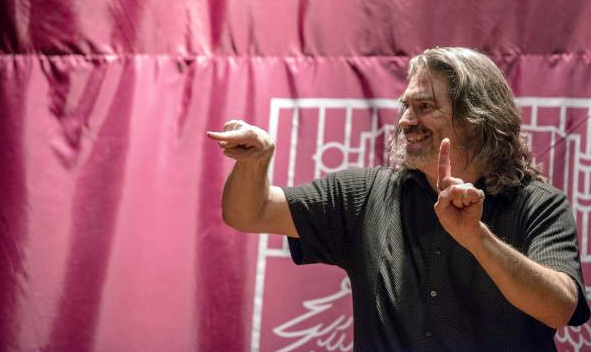Visiting Fellows Bring Expertise, Energy to Neubauer Collegium

This article originally appeared in UChicago News on 16 March.
An expert in classics and a scholar of comparative literature. A statistician and a historian of film. A deaf storyteller and experts in linguistics.
The Neubauer Collegium for Culture and Society supports ambitious faculty research projects that cut across disciplinary boundaries. Many of those projects include surprising collaborations between University of Chicago faculty members and Neubauer Collegium visiting fellows from around the world. The robust Neubauer Collegium Visiting Fellows Program supports both short- and long-term visits from guest scholars, facilitating an exchange of ideas that enriches the Neubauer Collegium’s projects.
These scholars have been a vital part of the success of the Neubauer Collegium, according to Roman Family Director Jonathan Lear.
“Visiting fellows are integral to the mission of the Neubauer Collegium. Their expertise and global perspective inform and expand the ambitious research led by our faculty fellows,” Lear said.
The program doesn’t simply benefit University of Chicago faculty—previous fellows say the experience was truly a two-way exchange.
Barbara Vinken, a scholar of comparative literature, has spent the last three months in Chicago collaborating with Michèle Lowrie on the project “Thinking Through Tropes: Figures of Thought and the Political Imaginary.”
The pair had long wanted to work on a project focused on the Roman legacy in the Western tradition, Vinken said. In Chicago, Lowrie and Vinken have been hard at work on a book about civil war.
Rather than examining civil wars as historical events, they are focused on “civil war as a cluster of tropes”—that is, a framework for people who have experienced such conflict to understand their own experiences.
Alongside their writing, Lowrie and Vinken also organized a seminar that assembled “a really interdisciplinary crowd” to discuss how tropes, allegory and metaphor shape history. Those conversations may result in a new edited volume, Vinken said.
Vinken said her time as a fellow was both positive and productive—a sentiment echoed by British statistician Michael Baxter.
‘RESEARCH THAT CROSSES BOUNDARIES’
Baxter came to Chicago last year to collaborate with Yuri Tsivian on his project “Cinemetrics Across Boundaries: A Collaborative Study of Montage.” That project uses quantitative data like average shot length to yield new insights into the history of cinema.
Throughout much of his career, Baxter found ways to apply statistical methods to problems in archeology. In retirement, however, he grew increasingly interested in film, particularly in silent film. He came across an early book on statistics and film, Barry Salt’s Statistical Film Analysis, which led him to Tsivian’s Cinemetrics website. Launched in 2005 as a digital tool designed to assess and compare various ways of editing films, Cinemetrics has grown into a global forum on experimental methods in cinema studies.
Before long, Baxter and Tsivian were engaged in an informal, transatlantic collaboration. “We’ve been exchanging ideas for several years,” Baxter explained.
Coming to Chicago as a visiting fellow allowed Tsivian and Baxter to work together more closely and collaborate on a conference, a research paper and someday, they hope, a book. The fellowship enabled “what I hope will be a continuing and productive program of research,” Baxter said.
The opportunity to put his statistical background to use on an interdisciplinary project like Cinemetrics was a welcome and an unusual one for Baxter. At other institutions, it can be difficult to secure funding for applied statistical research, he said.
“I think it’s fantastic that this initiative exists to encourage research that crosses boundaries,” Baxter said. “If you told me two-and-a-half years ago that I’d be talking about applying statistics to film, it’s not something I could have even dreamed of. It’s astonishing that it’s been made possible.”
Peter Cook was equally impressed by the partnerships facilitated by his fellowship. Cook is a deaf storyteller and performer who is collaborating with Profs. Sian Beilock, Diane Brentari, Anastasia Giannakidou and Susan Goldin-Meadow on their project, “The Body’s Role in Thinking, Performing and Referencing.” Among other efforts, the team is working on capturing linguistic data about American Sign Language, and hopes to raise awareness of ASL literature in the process.
“The Neubauer Collegium is a perfect place for doing this since there are abundant supports and resources on campus, and there are numerous available scholars who are experts in the field of non-verbal communication,” Cook wrote in an email. “Where else could you have all these people in the same room?”
The visiting fellows program continues to evolve. This year, the Neubauer Collegium supported fellows who were not associated with a single project and came to collaborate with a variety of faculty members on campus. Harvard historians David Armitage and Joyce Chaplin will participate in workshops and panel discussions, and will host informal “master classes” for graduate students and faculty members during their time at UChicago, according to Assoc. Prof. Jennifer Pitts, who is helping to coordinate their visits.
The Neubauer Collegium supports innovative and collaborative research projects led by University of Chicago faculty, hosts visiting fellows from around the world and pioneers efforts to engage a wider public in humanistic scholarship. In its first three years, the Neubauer Collegium has supported more than 25 fellows from eight countries.
The Neubauer Collegium will move into its new home at 5701 S. Woodlawn Ave in April. Originally built in 1933 for the Meadville Theological Seminary, the transformation of the building’s interior design will promote the Neubauer Collegium’s vision and ideals for collaborative forms of research in the humanities and social sciences, and their connections with other fields. A variety of spaces—including offices for visiting fellows—will enable University of Chicago faculty to work both with each other and with leading researchers from around the world.
